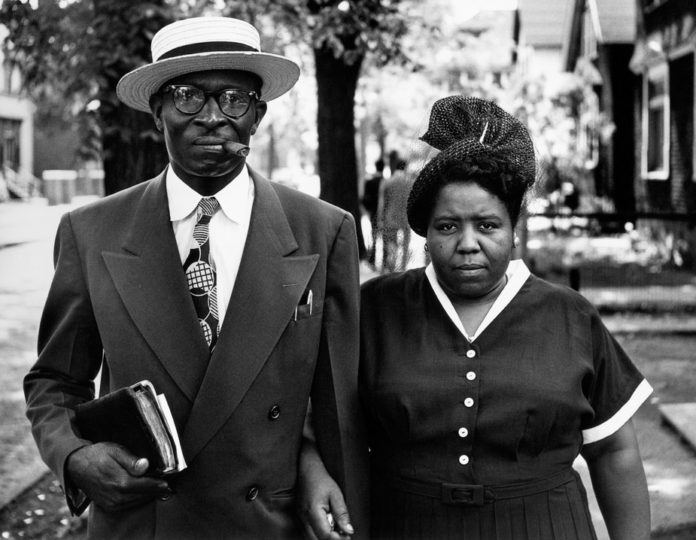
By Toni Pepe Dan, Boston University
In the spring of 1950, Gordon Parks, the first African-American photographer for Life Magazine, returned to his hometown of Fort Scott, Kansas. On assignment for the magazine, Parks photographed his middle school classmates, who were dispersed among Fort Scott and other Midwestern cities and towns.
The resulting images – while quite personal to Parks – offer a glimpse into a community and a set of experiences shared by many African Americans of his generation. Depicting the realities of discrimination without the veil of nostalgia, it’s a body of work that captures the resiliency of a community at a significant point in American history – just prior to the Civil Rights Movement.
But for reasons unknown, Life never published the series.
Now, the powerful exhibit of over 40 segregation-era images is on display at Boston’s Museum of Fine Arts.

Photograph by Gordon Parks. Courtesy and © The Gordon Parks Foundation. Courtesy Museum of Fine Arts, Boston
One of the first photographs confronting the viewer is of a weathered, middle-aged Caucasian man wearing overalls and a wide-brimmed hat. He’s standing, stone-faced, by the railroad tracks, and his eyes, though obscured by shadow, seem fixated on the viewer. He holds a large stop sign by his side, and his foot pivots out, as if to welcome us into the frame – but with only a shred of tolerance.

Photograph by Gordon Parks. Courtesy and © The Gordon Parks Foundation. Courtesy Museum of Fine Arts, Boston
This photograph, in particular, sets the tone for the entire exhibit because it positions the viewer squarely in Parks’ shoes. He is an African-American man returning to his hometown – a place with a history of segregation, but a place he nonetheless calls home. In this photograph, Parks cleverly sets up the dichotomy of home as both a site of comfort and trauma.
Only one of Parks’ former classmates, Luella Jones, still resided in Fort Scott at the time of the shoot. In another image, Parks photographed her – along with her husband, Clarence Hill, and daughter, Shirley Jean – gathered around the family’s piano.
The warmth of the home’s interior light contrasts with the wet, cold environment of the town center shown in a subsequent image of Shirley and her boyfriend, James Lewis. In the photograph, the young couple waits outside a movie theater, where their full-priced tickets still only qualify them for seats in the back. It’s an image that underscores the prejudice that permeates the time period and place, and Parks’ portrayal of a strong African-American family unit – alongside the discrimination they encountered daily – is a striking juxtaposition.
Meanwhile, the intimacy of Parks’ portraits is palpable. Uncle James, who Parks noted as being his true mentor, is shown hunched over in quiet contemplation. A soft light falls over James and the still, bucolic scene around him. His hand grips the hook of his cane as he stares off frame with a gaze of certainty. Parks’ portrait of his blind, elderly uncle conveys the admiration that he had for this particular family member and steers the viewer away from any feelings of pity.

Photograph by Gordon Parks. Courtesy and © The Gordon Parks Foundation. Courtesy Museum of Fine Arts, Boston
Furthermore, Parks – with his insider’s perspective – is able to transform banal moments into sacred ones. There’s an appreciation for ritual that’s pervasive throughout the collection. “Untitled, Kansas City, Missouri” depicts Peter Thompson, his wife Ada, and their 13-year-old daughter Marilyn Jane sitting around the dining room table enjoying a meal together. A light shines down from the high ceilings – the family glows – and an everyday moment is elevated to myth. The floral wallpaper, ornate rugs, and carved furnishings fill every inch of the frame and surround the family, who seem to find refuge from the decorative noise at the dinner table with one another.
In a different photograph, Parks captures another family meal. Fred and Mary Wells are shown saying grace sitting at a worn, small wooden table for two under a bare light bulb in their kitchenette-style apartment. The Wells’ home is stark compared to the Thompson’s, but it’s clear that Parks is drawing a parallel, emphasizing the intimacy of family and the notion of communion among his subjects.
Parks welcomes his viewers into his classmates’ warm inviting homes, but an atmosphere of emotional ambivalence exists throughout. In his portrait of the Wells couple, the two stand comfortably poised in front of their modest apartment. Their eyes confront the viewer exhibiting a secured, unified front.

Photograph by Gordon Parks. Courtesy and © The Gordon Parks Foundation. Courtesy Museum of Fine Arts, Boston
Ultimately, Park’s exhaustive attempt to track down each of his classmates and tell their respective stories exemplifies a devotion to his subjects that he practiced throughout his career. While Parks would go on to photograph icons like Malcolm X and Muhammad Ali, it was a return home that allowed him to convey complex themes that are both personal and universal: a reverence for routine, the tension of segregation, the grind of time’s gears – and, with it, the inevitability of loss: of childhood, of family, and of friends.
Gordon Parks: Back To Fort Scott will be on display at Boston’s Museum of Fine Arts until September 15 2015
![]()
This article was originally published on The Conversation.
Read the original article.




















